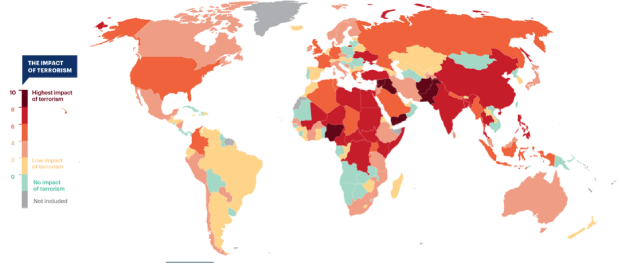The Changing Dynamics of Terrorism

The fourth edition of the Global Terrorism Index has been released this week. It provides a comprehensive summary of the key global trends and patterns in terrorism over the last 16 years. Despite a 10 per cent reduction in the number of deaths from terrorism in 2015, the Index records a 6 per cent increase in the impact of terrorism worldwide.
The annual Global Terror Index (GTI) by the Institute for Economics and Peace (IEP) analyses the direct and indirect impact of terrorism on 163 countries covering over 99 per cent of the world’s population. It uses data from the Global Terrorism Database that is collected and collated by the National Consortium for the Study of Terrorism and Responses to Terrorism and other sources.
The 2016 GTI finds that the total number of deaths resulting from terrorism in 2015 fell by 10 per cent, marking the first decline since 2010. This decrease can be attributed to military interventions against ISIL and Boko Haram in their central areas of Nigeria and Iraq, resulting in a 32 per cent reduction in deaths in these two countries when compared to 2014.
Conversely, expanded activities by both of these groups in other areas previously less affected by terrorism poses new threats. Boko Haram has expanded into Niger, Cameroon and Chad, increasing the number of people they have killed through terrorism in these three countries by 157 per cent. Similarly, ISIL and its affiliates were active in 15 new countries in 2015. This growing spread is largely why a number of countries recorded their highest levels of terrorism in any year in the past 16 years, making 2015 the second deadliest year on record.
The research by IEP found that the number of countries with greater than 25 deaths in 2015 rose to 34, an increase of seven from the previous year, to the highest number ever recorded. At least six countries saw very significant deteriorations in their GTI scores in 2015 leading to large rank changes from the previous year. These countries include France, Turkey, Saudi Arabia, Kuwait, Tunisia and Burundi. This accounted for the overall deterioration in the global GTI score of 6 per cent as these falls outweighed the substantial gains in Nigeria and Iraq and some further gains in countries including India and Pakistan.
In 2015, there was a surge in deaths from terrorism in OECD countries. This increase has been driven principally by ISIL’s transnational tactics in combination with lone actor attacks inspired by the group. This sharp spike in deaths saw a 650 per cent increase from the previous year, with 21 of the 34 OECD countries experiencing at least one attack.
The research found that not only was there a significant increase in deaths from terrorism in OECD member countries, but in the overall number of attacks across a wider range of countries, with the majority of deaths occurring in Turkey and France. The sheer volume of attacks suggests that terrorism is a much greater threat to political stability in OECD countries.
Importantly, this year’s findings reaffirm that terrorist activity, while spreading, still remains highly concentrated, with 57 per cent of all deaths since 2000 occurring in four countries: Iraq, Afghanistan, Nigeria and Pakistan. Iraq retains the position as the most affected country and accounts for 30 per cent of the deaths over the 16-year period.
IEP’s researchers conduct a wide range of statistical tests to identify the most statistically significant factors associated with terrorist activity. Results of this analysis have found that there is a strong correlation between terrorism and a nation’s levels of political terror and ongoing conflict. Only 0.5 per cent of terrorist attacks occurred in countries that did not suffer from armed conflict or have high levels of state sponsored terror. Terrorist activity within OECD countries shows that other factors associated with terrorism are socioeconomic indicators such as youth unemployment, levels of criminality, access to weapons and distrust in the electoral process. Whereas, in developing countries, levels of corruption and group-based inequalities are most significantly correlated to terrorist activity.
The findings of this year’s GTI show that while overall numbers of deaths have gone down, the impact and fear of terrorism continues to grow—most significantly in OECD member countries. This highlights the need for the international community to deepen its understanding of the properties and drivers of terrorism in order to establish policies for both countering violent extremism and terrorist activities.
Camilla Schippa is the director of the Institute for Economics and Peace.
To access interactive maps on the Global Terrorism Index and to view the full report click here.
This article has been published under a Creative Commons Licence and may be republished with attribution.




